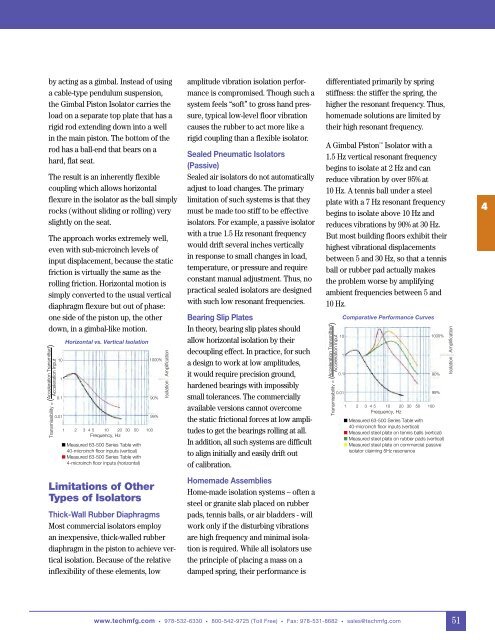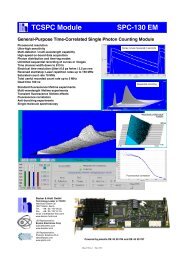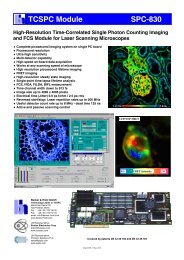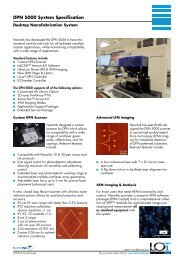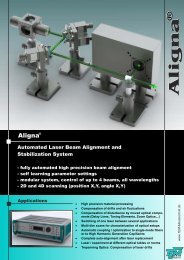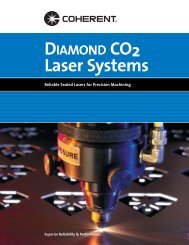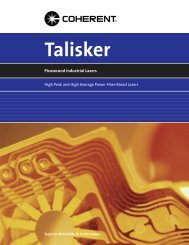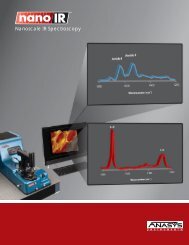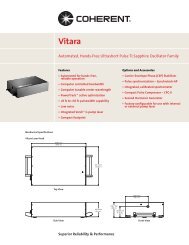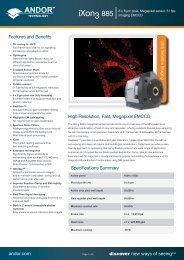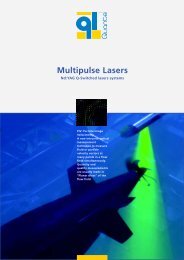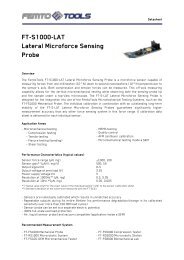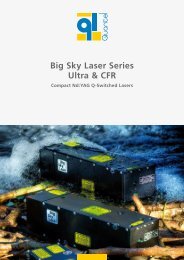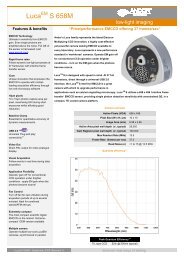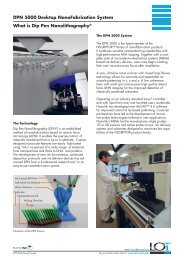Create successful ePaper yourself
Turn your PDF publications into a flip-book with our unique Google optimized e-Paper software.
y acting as a gimbal. Instead of usinga cable-type pendulum suspension,the Gimbal Piston Isolator carries theload on a separate top plate that has arigid rod extending down into a wellin the main piston. The bottom of therod has a ball-end that bears on ahard, flat seat.The result is an inherently flexiblecoupling which allows horizontalflexure in the isolator as the ball simplyrocks (without sliding or rolling) veryslightly on the seat.The approach works extremely well,even with sub-microinch levels ofinput displacement, because the staticfriction is virtually the same as therolling friction. Horizontal motion issimply converted to the usual verticaldiaphragm flexure but out of phase:one side of the piston up, the otherdown, in a gimbal-like motion.Transmissibility = ( Acceleration Transmitted )Acceleration Input1010.10.01Horizontal vs. Vertical Isolation1 2 3 4 5 10 20 30 50 100Frequency, Hz■ Measured 63-500 Series Table with40-microinch floor inputs (vertical)■ Measured 63-500 Series Table with4-microinch floor inputs (horizontal)1000%90%99%Isolation Amplificationamplitude vibration isolation perfor -mance is compromised. Though such asystem feels “soft” to gross hand pressure,typical low-level floor vibrationcauses the rubber to act more like arigid coupling than a flexible isolator.Sealed Pneumatic Isolators(Passive)Sealed air isolators do not automaticallyadjust to load changes. The primarylimitation of such systems is that theymust be made too stiff to be effectiveisolators. For example, a passive isolatorwith a true 1.5 Hz resonant frequencywould drift several inches verticallyin response to small changes in load,temperature, or pressure and requireconstant manual adjustment. Thus, nopractical sealed isolators are designedwith such low resonant frequencies.Bearing Slip PlatesIn theory, bearing slip plates shouldallow horizontal isolation by theirdecoupling effect. In practice, for sucha design to work at low amplitudes,it would require precision ground,hardened bearings with impossiblysmall tolerances. The commerciallyavailable versions cannot overcomethe static frictional forces at low amplitudesto get the bearings rolling at all.In addition, all such systems are difficultto align initially and easily drift outof calibration.differentiated primarily by springstiffness: the stiffer the spring, thehigher the resonant frequency. Thus,homemade solutions are limited bytheir high resonant frequency.A Gimbal Piston Isolator with a1.5 Hz vertical resonant frequencybegins to isolate at 2 Hz and canreduce vibration by over 95% at10 Hz. A tennis ball under a steelplate with a 7 Hz resonant frequencybegins to isolate above 10 Hz andreduces vibrations by 90% at 30 Hz.But most building floors exhibit theirhighest vibrational displacementsbetween 5 and 30 Hz, so that a tennisball or rubber pad actually makesthe problem worse by amplifyingambient frequencies between 5 and10 Hz.Transmissibility = ( Acceleration Transmitted )Acceleration Input10Comparative Performance Curves10.10.011000%90%99%1 2 3 4 5 10 20 30 50 100Frequency, Hz■ Measured 63-500 Series Table with40-microinch floor inputs (vertical)■ Measured steel plate on tennis balls (vertical)■ Measured steel plate on rubber pads (vertical)■ Measured steel plate on commercial passiveisolator claiming 5Hz resonanceIsolation Amplification4Limitations of OtherTypes of IsolatorsThick-Wall Rubber DiaphragmsMost commercial isolators employan inexpensive, thick-walled rubberdiaphragm in the piston to achieve verticalisolation. Because of the relativeinflexibility of these elements, lowHomemade AssembliesHome-made isolation systems – often asteel or granite slab placed on rubberpads, tennis balls, or air bladders - willwork only if the disturbing vibrationsare high frequency and minimal isolationis required. While all isolators usethe principle of placing a mass on adamped spring, their performance iswww.techmfg.com • 978-532-6330 • 800-542-9725 (Toll Free) • Fax: 978-531-8682 • sales@techmfg.com51


